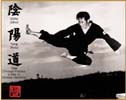An Explanation of
|
|---|

One of the many...
|
 One of the many... |
Hyung (Figure of Movement)Hyung has been more-deeply explained (intermediate level) in this section to further your understanding of the depth of Moo Doe movement. Each Hyung form is comprised of a series of movements that are derived from elements of nature (i.e.; moving your body the way the ocean surf moves: Tang Nang, or moving your body the way a tiger moves:Ho Bar Too) - through instinct, some wild animals use different movements to correct or cure physical problems. Each individual Hyung took generations to develop; and have characteristics and benefits that are unique to that particular form. Through practicing these movements, the characteristics and benefits that are unique to that part of nature are instilled into the way the practitioner moves. No two people practicing the same Hyung movement will develop in exactly the same way. Unique to Hyung development is the ability for practitioners of all age groups to have unlimited potential to gain strength, mentally and physically, through the practice of Hyung, with no risk of injury. Naturally-occurring illnesses can be cured with certain Hyung movements (matching by the individual). There are five main points in practicing Hyung. All five points must be balanced with each other in fluid motion. Hyung is commonly referred to as softer form (circle soft, hit hard):
Tang Nang: Movements derived from the elements of nature; the strength and character of the ocean. Tang Nang is an example of a Hyung that has movements derived from an element of nature, the ocean surf:
Tang Nang (and all Hyung) movements must harmonize with an individual's type of body; otherwise, a practitioner can practice for years and never realize the maximum benefits. A practitioner must feel each Hyung movement; there may be combinations of fast and slow, soft and hard, and circular movement. The hands and feet move in unison with the entire body. Proper breathing is also timed with each movement.
| |||||||||||||||||||||||||||